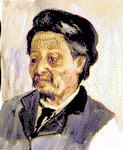 |
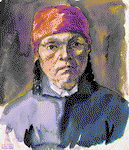 |
| Jimmie, 1928, watercolour | Louisa, 1928, watercolour |

 |
 |
| Jimmie, 1928, watercolour | Louisa, 1928, watercolour |
"Jimmie had a good boat. He and his wife, Louisa, agreed to take me to the old villages of Tanoo, Skedans, and Cumshewa, on the southern island of the Queen Charlotte group.
...We chugged and bobbed over all sorts of water and came to Tanoo in the evening. It looked very solemn as we came nearer. Quite far out from land Jimmie shut off the engine and plopped the anchor into the sea. Then he shoved the canoe overboard, and putting my sheep dog and me into it, nosed it gently through the kelp. The grating of our canoe on the pebbles warned the silence that we were come to break it.
It was so still and solemn on the beach, it would have seemed irreverent to speak aloud; it was as if everything were waiting and holding its breath. The dog felt it too; he stood with cocked ears, trembling. When the others came and moved about and spoke this feeling went away...
 |
 |
| Tanoo, 1912, watercolour & pencil | Tanoo, Q.C.I., 1913 |
At one side of the Tanoo beach rose a big bluff, black now that the sun was behind it. It is said that the bluff is haunted. At its foot was the skeleton of a house; all that was left of it was the great beams and the corner posts and two carved poles one at each end of it. Inside, where people used to live, was stuffed with elderberry bushes, scrub trees and fireweed. In that part of the village no other houses were left, but there were lots of totem poles sticking up."
--Klee Wyck, pp.12-13
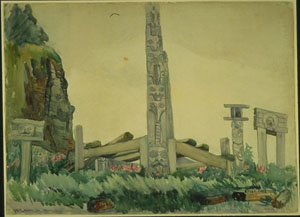 |
| Skedans, 1912, watercolour & pencil |
"Skedans was more open than Tanoo. The trees stood farther back from it. Behind the bay another point bit deeply into the land, so that light came in across the water from behind the village too.
There was no soil to be seen. Above the beach it was all luxuriant growth; the earth was so full of vitality that every seed which blew across her surface germinated and burst. The growing things jumbled themselves together into a dense thicket; so tensely earnest were things about growing in Skedans that everything linked with everything else, hurrying to grow to the limit of its own capacity; weeds and weaklings alike throve in the rich moistness.
...Skedans Beach was wide. Sea-drift was scattered over it. Behind the logs the ground sloped up a little to the old village site. It was smothered now under a green tangle, just one grey roof still squatted there among the bushes, and a battered row of totem poles circled the bay; many of them were mortuary poles, high with square fronts on top. The fronts were carved with totem designs of birds and beasts. The tops of the poles behind these carved fronts were hollowed out and the coffins stood, each in its hole on its end, the square front hiding it. Some of the old mortuary poles were broken and you saw skulls peeping out through the cracks."
--Klee Wyck, pp. 17-18
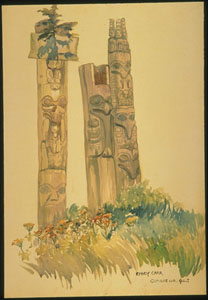 |
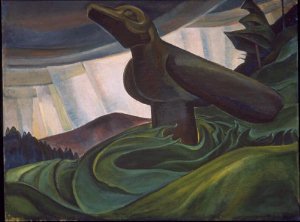 |
| Cumshewa, Q.C.I., 1912, watercolour | Big Raven, 1931, oil |
"Tanoo, Skedans and Cumshewa lie fairly close to each other on the map, yet each is quite unlike the others when you come to it. All have the West Coast wetness but Cumshewa seems always to drip, always to be blurred with mist, its foliage always to hang wet-heavy. Cumshewa rain soaked my paper, Cumshewa rain trickled among my paints.
Only one house was left in the village of Cumshewa...Not far from the house sat a great wooden raven mounted on a rather low pole; his wings were flattened to his sides. A few feet from him stuck up an empty pole. His mate had sat there but she had rotted away long ago, leaving him moss-grown, dilapidated and alone to watch dead Indian bones, for these two great birds had been set, one on either side of the doorway of a big house that had been full of dead Indians who had died during a smallpox epidemic.
Bursting growth had hidden house and bones long ago. Rain turned their dust into mud; these strong young trees were richer perhaps for that Indian dust. They grew up round the dilapidated old raven, sheltering him from the tearing winds now that he was old and rotting because the rain seeped through the moss that grew upon his back and in the hollows of his eye-sockets. The Cumshewa totem poles were dark and colourless, the wood toneless from pouring rain."
--Klee Wyck, pp. 20-21

 |
 |
 |
 |
 |
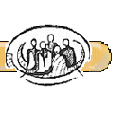 |
| Gallery | Tour | Family | Writing | Issues | Team |